-
Posts
2,397 -
Joined
-
Last visited
-
Days Won
66
Content Type
Profiles
Forums
Downloads
Gallery
Posts posted by jgcode
-
-
What version of LabVIEW are you seeing this in?
-
At the moment while a test is running i want a "loading" type of gif to be playing. At the moment I'm inserting a VI containing the gif into a subpanel and then removing it once its no longer needed. Is there an easier/more elegant way?? Maybe a ring control with all the images, but even then i'll still need to insert the VI into the subpanel.
Attached is the VI containing the gif.
Hi kiyuna
I like to add the gif to a button with the 'on image' as the gif and the 'off image' as a png-still of the gif. Then I just set the button state programmatically.
You could do the same but just use the visible property of the button to show/hide the gif.
Cheers
-JG
-
(at this point I don't know if other programs that were developed in 8.5 will be able to handle the change).
Good to hear you have sorted out your issue.
As for the change you mentioned this actually occurred in LabVIEW 2009. I have not had any issues with the config API with respect to this. Given LabVIEW handles the change automatically and the OpenG Config VIs are based on that API (and package versions 4.x have been tested in LabVIEW 2009) it should be all sweet.

Cheers
-JG
-
I'm using LabVIEW 2011 (2010 SP1 (v10,0.1)). The option in the File menu that this is supposed to create is not appearing.
Hi caleyjag
I am confused as to whether you are using 2011 or 2010, anyways I have tested this package and it installs correctly in 2011:
Have you rebooted LabVIEW after installing the package?
This is required to refresh the menu (currently there is no way to do this programmatically etc...)
Cheers
-JG
-
You:
Similar:
Yes, I am a google master.
-
 1
1
-
-
Still, being consistent doesn't make it understandable. Having taken the exam twice now, I still have no idea of what they're looking for in a solution. It makes it very hard to prepare for an open-ended exam.
Personally, when I took the exam, I didn't find it difficult in knowing as to what NI were after - what I found difficult was comprehension of the requirements and implementing the solution within the time limit.
After compiling notes, I used a top-down approach - I put together the messaging framework, then UI, then worked on creating modules (specifically API and data-structures), then connecting everything together. I then kept iterating through everything (either adding code or requirement covers) - rather than trying to implement an entire module in one go - because I knew I would be pushed for time (and of course I needed more time). IMO the CLA Prep Guide details pretty well what NI are after (page 9-10), if you can tick off those boxes, you should feel pretty confident in passing the exam.
-
Naaah. I'd prefer it like like JGs. You would have made a huge profit in only 3 weeks.

All I can say is to invest (going with the stock market theme) in OpenG - if you are interested in becoming an OpenG Developer please PM me!
-
I vote to add an I32 VI (using Jim's code) and polymorphize the API.
We can look at supporting more datatypes in the future when there are good enough reasons to do so.
-
 1
1
-
-
Congrats. Well deserved! :beer:
-
Two suggestions:
- use the Icon of the polymorphic instance instead of the icon of the polymorphic VI.
- Add a to-lower-case in the Hexidecimal VI, LabVIEW formats HEX with UPPERcase, while we've seen that the official standard is lowercase
Ton
Good suggestions Ton.
- use the Icon of the polymorphic instance instead of the icon of the polymorphic VI.
-
This review is now closed - thanks to Wouter for the original contribution and thanks everyone for their input.
Significant contributions will appear in the copyright of the released version.
Cheers!
-
The OpenG Board has decided to use on the following icon and connector pane:
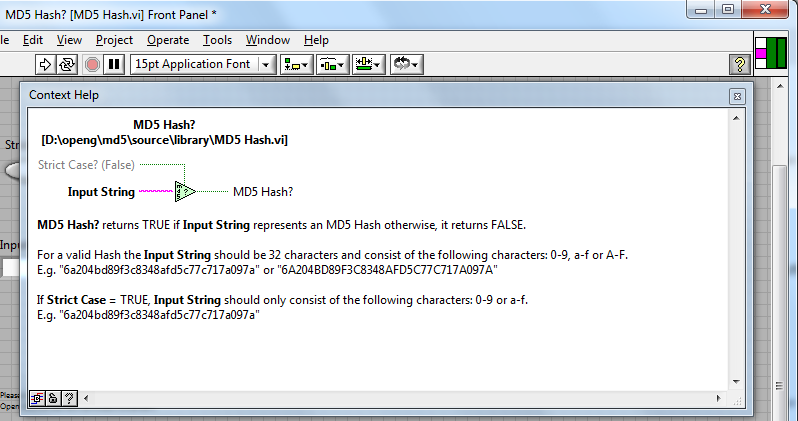
Additionally (as suggested in this thread) a Hexademical String output has been added to MD5 Message Digest.
This could have been implemented in two ways:
- Depreciated old VI, create new VI and add additional output
- Convert to Polymorphic API
The Polymorphic API was chosen as it allows for future support of additional outputs (if ever needed).
Note: It will not break existing code.
The Hexadecimal String is just a thin wrapper around the original VI:
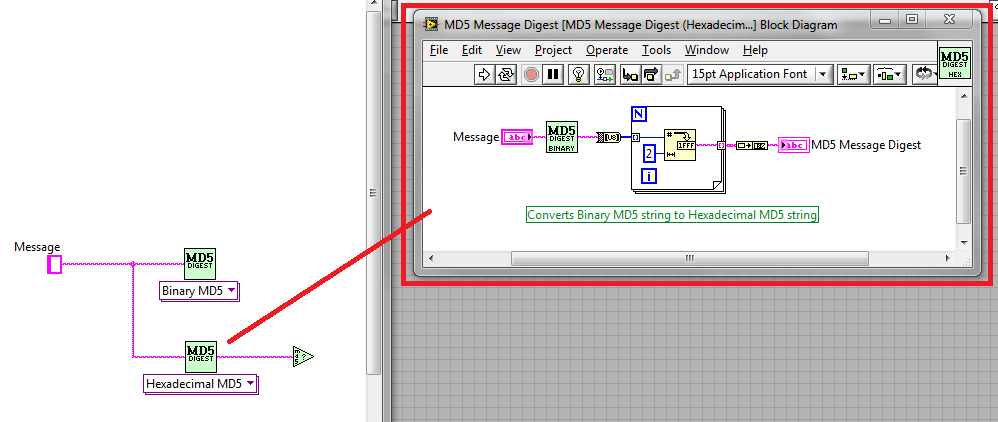
I will close this review in the next few days.
Thanks for everyone's input!
-
 1
1
- Depreciated old VI, create new VI and add additional output
-
What do we want to do? Should we load the sourceforge files into this thread?
I would do whatever makes it easy for reviewers to get to the code to contribute to this thread.
E.g. post a zip containing everything for a one-click download (as opposed to 30+ clicks)

-
 1
1
-
-
As I pointed out in the previous thread as well, you can use the Sign function to convert R (the remainder of the integer division) to 0 or 1, instead of the three functions you use here. Also, this value R gives you already the number of padding characters required, which could be added to the Input String before processing - depending on the memory effects of doing this. Doing all that could simplify the diagram somewhat.
As I said in the other thread, I liked your implementation better.

What is the reason for outputting the Last Character? Is there an obvious use for this?
I wrote this code a while but only just posted it. At the time I was thinking it may be of interest for padding etc...
Like I said above, I posted the VI to get a discussion going on functionality so things like these are not that important at this stage.
-
Now that kind of skinnable, thim UI sounds very interesting. Any examples you can post?
On the road, so don't have any examples with me however, the JKI Module presentation shows how you can 'fit' a UI onto another module and the old LabVIEW Advanced course showed two examples (Event Structure and Queues) for doing this - if you can get your hands on that book it is a good read.
Cheers!
-
I have updated the LAVA requirements to include changes to the palette location and .bin3 location.
These changes are to be inline with Compatible with LabVIEW (LabVIEW 2011) requirements.
-
Perhaps we could get some momentum on the idea exchange for allowing palettes to be placed under the lower level palettes (i.e. arrays, timing, etc). I'll post an idea for this and update this thread when I do so.
OpenG used to support this functionality (by recreating all the NI palettes I believe?)
This was something I posted to JKI last year as a feature for VIPM however, I understand it is a limitation of LabVIEW palettes.
So, I am all for this Idea happening!!
-
Just so we are all on the same page, the change is not as small as advertised (not that it is that big a deal).
Yes, it was not a big deal to implement the multi-character functionality (that is what I meant).
I think you need to use sign( R ) like this:
I did it similar to this when I coded it, but I like the above better.
handling the case where the data size is not commensurate with the chunk size (padding or clipping). The offset must be multiplied by the chunk size as well.This is the part that will generate some discussion on how to handle it.
I have gone ahead and created a separate thread for a Chunking VI so please continue this discussion there (I also posted some code to get the above mentioned functionality).
I am going to go ahead and close this review in a couple of days.
OpenG will be using the original String To Character Array function (note the name change) as below:
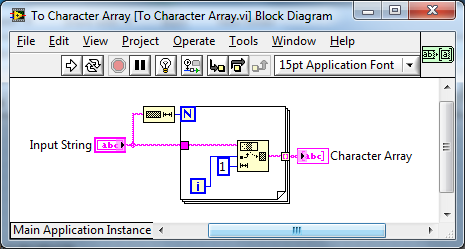
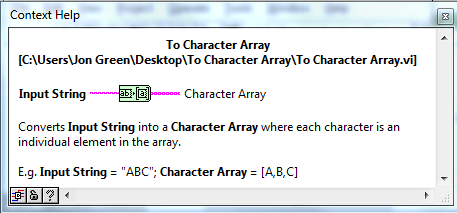
-
 1
1
-
-
I have started a new thread for the possibility of creating a Chunking VI or similar.
Here is some code I wrote to get the conversation started.
It may not be beautiful code, but I was just trying to create the functionality described in the cross thread (did I get it right?)
I will turn this into an OpenG review if it gets enough interest.
Attached is a String Implementation
Code is in LabVIEW 2009
-
I think his is better. Rather than duplicate Jim's post and test code, is there a way we can import the discussion from the OpenG board to the LAVA board?
Cut and paste.
I am sure everyone who is interested in the discussion can click to the OpenG archive and read the OP.
Keep that thread going by posting in this LAVA thread, no worries.
-
I achieved what I was trying to do by having no timeout and writing the stop condition of the stop loop to a property node (value(signalling)) linked to the control bool.
Still don't know why having a time out causes the control to become unresponsive.
Just guessing:
Is it because you are not initializing that local variable and you have a race condition?
.
-
Of course... I am thumping my head on the table right now. Sorry for wasting everyones time.
Don't worry it's not like we never went through the same exercise figuring this out. Learning is fun!
-
...the sub-VI that handle each of the modes the app runs in.
Another example includes making skinable UIs - if you want to have two different UI themes or resolutions etc... The UIs should be thin (to avoid redundancy) and you have an engine VI to handle events.
I have made a thin UI before so as to disassociate the UI from engine. Its more work but can be beneficial.
-
Thank your for all the help on this, it makes better sense now.
The only thing I'm left wondering is when I would use the default implementation of an override method (ie call parent method), it doesn't seem to be any use apart from as a placeholder.
It allows for code reuse. It's use is really going to be dependent on your class structure / project.



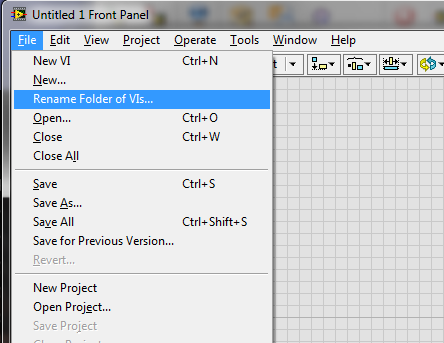
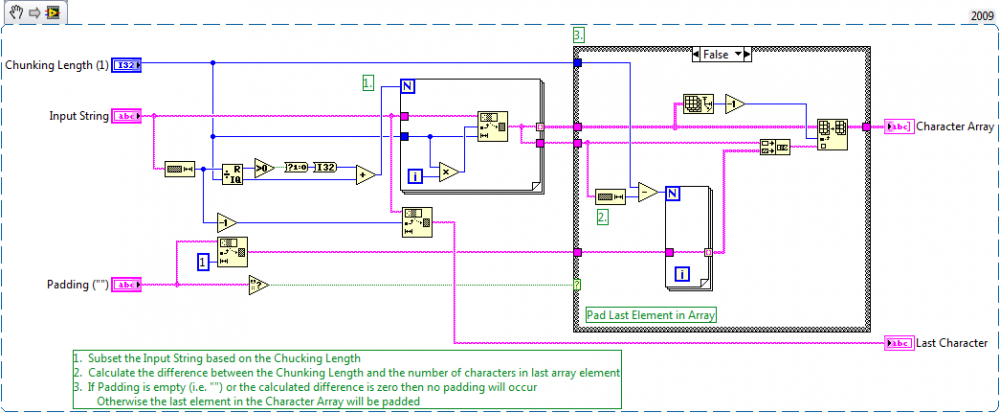
Random Number - Integer (Numeric Package)
in OpenG Developers
Posted
FWIW, there's two conversion dots there.